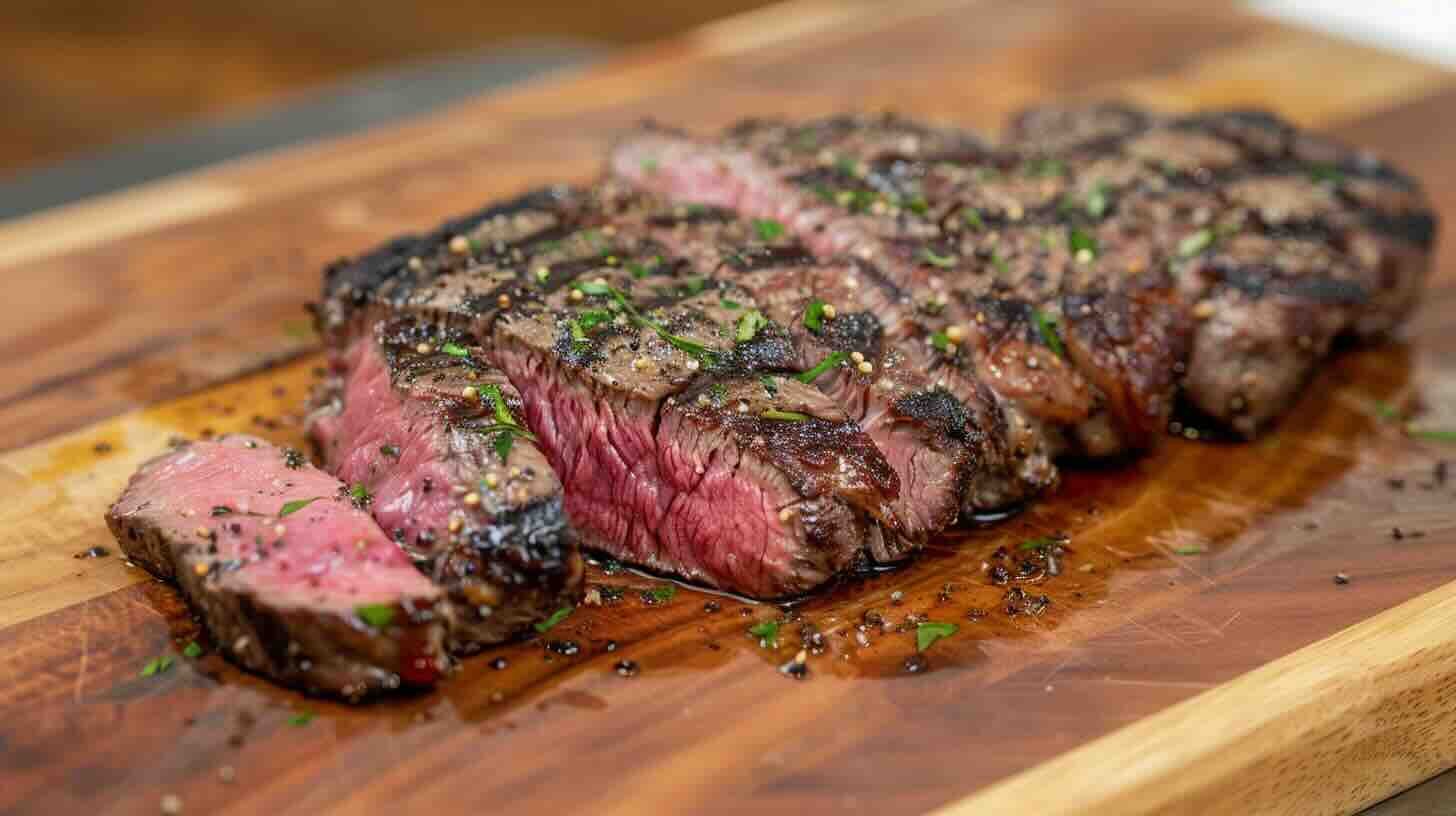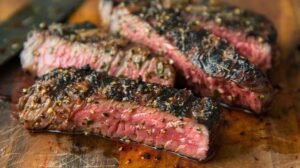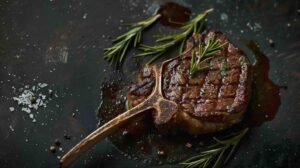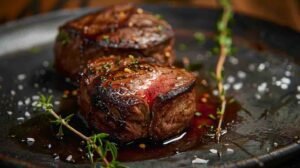Exploring Reverse Searing
The Reverse Sear Method
The reverse sear method is a popular cooking technique that transforms a steak into a culinary masterpiece. This method involves slow-cooking a steak in the oven at a low temperature before finishing it off with a hot sear. The process ensures a perfectly cooked interior and a flavourful, crispy exterior, making it ideal for thick cuts of meat like ribeye steaks.
“As an Amazon Associate, I earn from qualifying purchases.”
Steps in the Reverse Sear Method:
- Preheat the Oven: Set your oven to a low temperature, around 225°F (107°C).
- Season the Steak: Generously season your ribeye with salt and pepper or your preferred steak seasoning.
- Slow Cook: Place the steak on a wire rack over a baking sheet and cook it in the oven until it reaches an internal temperature of 120°F (49°C) for medium-rare.
- Rest the Steak: Allow the steak to rest for a few minutes after removing it from the oven.
- Sear: Heat a skillet over high heat and sear the steak for about 1-2 minutes per side until a dark, crispy crust forms.
For more detailed instructions, visit our guide on how to reverse sear steak.
Benefits of Reverse Searing
Reverse searing offers multiple advantages that make it a preferred method for cooking steaks, especially rib eyes.
Even Cooking
The slow-cooking process in the oven ensures that the steak is cooked evenly from edge to edge, eliminating the risk of a gray band of overcooked meat around the edges.
| Cooking Method | Even Cooking (1-10) |
|---|---|
| Traditional Sear | 6 |
| Reverse Sear | 9 |
Better Browning
Reverse searing helps to create a better crust by reducing surface moisture on the steak, allowing for faster and more effective browning. This results in a crisp, darkly browned crust that is both visually appealing and delicious (Serious Eats).
Enhanced Tenderness
As the meat slowly heats up in the oven, enzymatic tenderization occurs, making the steak more tender. This method also allows for better control over the final product, offering a tender, juicy interior with a rosy pink center.
Moisture Retention
Reverse searing helps to lock in moisture, ensuring that the steak remains juicy throughout. By starting with a low, steady temperature, the meat retains more of its natural juices, resulting in a more succulent steak.
For those looking to explore other cuts and variations, check out our articles on reverse sear filet mignon and reverse sear tomahawk steak.
Perfecting the Reverse Sear
Achieving steak nirvana with the reverse sear method requires attention to detail and an understanding of the key steps involved. This section covers choosing the right cut, executing the reverse sear, and the importance of temperature control.
Choosing the Right Cut
For the reverse sear method, selecting the right cut of steak is crucial. The technique is best suited for thick cuts of meat, preferably at least 1 1/2 to 2 inches thick. Thicker cuts allow for even cooking without overcooking the exterior.
“As an Amazon Associate, I earn from qualifying purchases.”
| Cut | Recommended Thickness |
|---|---|
| Ribeye | 1.5 – 2 inches |
| Filet Mignon | 1.5 – 2 inches |
| Tomahawk Steak | 2 inches |
Choosing thicker cuts ensures that the steak remains juicy and tender, benefiting from the slow, even cooking process followed by a high-heat sear. For more information on specific cuts, check out our guides on reverse sear filet mignon and reverse sear tomahawk steak.
Executing the Reverse Sear
The reverse sear method involves slow cooking the steak in the oven at a low temperature before finishing it off with a hot sear. This technique ensures even cooking and a perfect crust.
“As an Amazon Associate, I earn from qualifying purchases.”
- Preheat the Oven: Set your oven to 225°F (107°C).
- Season the Steak: Generously season the steak with salt and pepper.
- Cook in the Oven: Place the steak on a wire rack over a baking sheet and cook until the internal temperature reaches about 10-15°F below your desired doneness.
- Rest the Steak: Remove the steak from the oven and let it rest for 5-10 minutes. This allows the juices to redistribute.
- Sear the Steak: Heat a cast-iron skillet over high heat. Add a small amount of oil with a high smoke point. Sear the steak for 1-2 minutes on each side until a dark brown crust forms.
For detailed instructions on this process, visit our comprehensive guide on how to reverse sear steak.
Importance of Temperature Control
Accurate temperature control is vital when using the reverse sear method. It ensures that the steak is cooked evenly and achieves the desired level of doneness without overcooking.
| Desired Doneness | Target Temperature (°F) | Remove from Oven (°F) |
|---|---|---|
| Rare | 120-125 | 110-115 |
| Medium Rare | 130-135 | 120-125 |
| Medium | 140-145 | 130-135 |
To achieve a perfect medium/medium-rare steak, consider removing the steak about 3-5 degrees before it reaches the target temperature, as it will continue to cook slightly from residual heat during resting. This ensures even doneness and maintains the steak’s juiciness.
The reverse sear method’s combination of low and high heat creates a perfect edge-to-edge medium rare without any gray or overcooked gradient (Jess Pryles). For more tips and tricks, visit our reverse sear steak recipe.
By understanding the importance of choosing the right cut, executing the reverse sear, and maintaining precise temperature control, anyone can master the art of the reverse sear ribeye steak.
Reverse Searing Ribeye Steaks
Reverse searing ribeye steaks involves a two-step cooking process that ensures a perfectly cooked steak with a beautiful crust and a juicy, tender interior. This method is ideal for achieving steak nirvana.
Cooking in the Oven
Begin by preheating your oven to 250 degrees Fahrenheit. Place the ribeye steaks on a wire rack set over a baking sheet. This setup allows for even air circulation around the steaks, ensuring uniform cooking. Insert a meat thermometer into the thickest part of the steak.
Bake the steaks in the oven for 20 to 25 minutes, or until the thermometer reads 115 degrees Fahrenheit for medium-rare. This slow, gentle cooking process ensures that the steaks cook evenly from edge to edge.
| Doneness | Internal Temperature (Oven) |
|---|---|
| Medium-Rare | 115°F |
| Medium | 125°F |
Searing to Perfection
After the ribeyes have reached the desired internal temperature in the oven, it’s time to sear them to perfection. Heat a cast iron or carbon steel skillet over high heat until it is smoking hot. Add a small amount of high smoke point oil, such as vegetable or canola oil, to the skillet.
Place the ribeyes in the skillet and sear one side until it is golden brown, typically around 1-2 minutes. Flip the steaks and continue searing the other side until the internal temperature reaches 130 degrees Fahrenheit for medium-rare or 140 degrees Fahrenheit for medium (Kansas City Steaks).
For detailed steps on how to reverse sear steak, visit our guide on how to reverse sear steak.
Serving and Presentation
Once the ribeyes are seared to perfection, let them rest for a few minutes to allow the juices to redistribute. Slice the steaks against the grain to ensure maximum tenderness.
For a flavorful finishing touch, top the ribeyes with a green herb sauce made from parsley, garlic, red chilies, lemon zest, lemon juice, and olive oil. Serve the steaks with a side of little gem salad with homemade Roquefort dressing and roasted fingerling potatoes with Parmesan for a well-rounded meal.
For more mouth-watering steak recipes, explore our articles on reverse sear filet mignon and reverse sear tomahawk steak.
Mastering the Art
Achieving steak nirvana with the reverse sear ribeye technique requires mastering a few essential elements. Here, we delve into tips for success, the necessary tools and equipment, and variations and flavour enhancements to elevate your steak game.
Tips for Success
- Start with a Thick Cut: A ribeye that is at least 1.5 inches thick works best.
- Dry the Steak: Pat the steak dry with paper towels to ensure a good sear.
- Season Generously: Use salt and pepper liberally for a flavourful crust.
- Slow and Low: Cook the steak slowly in the oven at a low temperature (250°F) to ensure even cooking.
- Rest the Steak: Allow the steak to rest for 5-10 minutes after the initial cook.
- Sear Hot and Fast: Use a high heat for a quick sear to create the perfect crust.
- Monitor Temperature: Use a meat thermometer to achieve the desired doneness.
| Doneness | Internal Temperature (°F) |
|---|---|
| Rare | 120-125 |
| Medium Rare | 130-135 |
| Medium | 140-145 |
| Medium Well | 150-155 |
| Well Done | 160-165 |
Tools and Equipment
- Meat Thermometer: Essential for monitoring internal temperature.
- Cast Iron Skillet: Ideal for achieving a perfect sear.
- Wire Rack and Baking Sheet: For even heating in the oven.
- Tongs: For flipping the steak without piercing it.
- Aluminium Foil: To tent the steak while it rests.
For detailed guidance on equipment, refer to our article on how to reverse sear steak.
Variations and Flavour Enhancements
- Herb Butter: Top your steak with a pat of herb-infused butter for added richness.
- Garlic and Rosemary: Sear the steak with crushed garlic and fresh rosemary for aromatic depth.
- Peppercorn Crust: Coat the steak with crushed peppercorns before searing to add a bold, spicy flavour.
- Pan Drippings Sauce: Use the pan drippings to create a savoury sauce by deglazing with wine or broth.
For more creative ideas, explore our reverse sear steak recipe collection.
By integrating these tips, tools, and variations into your cooking routine, you’ll be well on your way to mastering the art of the reverse sear ribeye steak. Enjoy experimenting with flavours and techniques to create your perfect steak experience.



